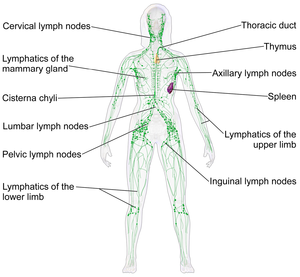Lymphatic System

The Lymphatic System is a network of tissues and organs that help rid the body of toxins, waste and other unwanted materials. The primary function of the lymphatic system is to transport lymph, a fluid containing infection-fighting white blood cells, throughout the body.
The Lymphatic System is part of the circulatory system and a vital part of the immune system, comprising a network of lymphatic vessels that carry a clear fluid called lymph directionally towards the heart. The lymphatic system consists of lymphatic organs, a conducting network of lymphatic vessels, and the circulating lymph. The thymus and the bone marrow constitute the primary lymphoid organs involved in the production and early clonal selection of lymphocyte tissues. Bone marrow is responsible for both the creation of T cells and the production and maturation of B cells. From the bone marrow, B cells immediately join the circulatory system and travel to secondary lymphoid organs in search of pathogens. T cells, on the other hand, travel from the bone marrow to the thymus, where they develop further. Mature T cells join B cells in search of pathogens. The other 95% of T cells begin a process of apoptosis (programmed cell death).[1]
At the cellular level, the lymphatic system is a pathway through which fluid flows from the intercellular spaces into the blood. The lymphatic system includes lymph, lymphocytes, lymph vessels, lymph nodules, lymph nodes, tonsils, Spleen and Thymus Gland. Part of the body’s defense system, the lymph nodes filter lymph and the spleen filters blood, removing microorganisms and other foreign substances. The lymph nodes act as a filtration system that keeps particulate matter such as bacteria from entering the bloodstream. They produce both lymphocytes and monocytes. Lymph tissue contains lymphocytes and other cells that can destroy microorganisms and foreign substances.
Brain to Lymph

Scientists discovered that the brains of mice contain functional lymphatic vessels that can carry fluid and immune cells from cerebrospinal fluid.
Fluids move throughout the body via several paths. The cardiovascular system circulates blood, nutrients, and gases throughout the body. The lymphatic system carries white blood cells and other immune cells through a network of vessels and tissues, including lymph nodes. The lymphatic system also serves as a connection between tissues and the bloodstream, performing several functions such as removing dead blood cells and other waste.
The Brain, part of the central nervous system, has blood vessels but has been thought to lack lymphatic vessels. Researchers recently discovered a series of channels that surround blood vessels within the brain. This system, managed by the brain's glial cells, was termed the glymphatic system. It moves cerebrospinal fluid, a clear liquid surrounding the brain and spinal cord, quickly and deeply throughout the brain, removing waste.The discovery of a pathway for immune cells to exit the central nervous system raises the question of whether disruption of this route may be involved in neurological disorders that are associated with immune system dysfunction, such as multiple sclerosis, meningitis, and Alzheimer’s disease.[2]
Meninges Immune Cell
The meningeal lymphatic vessels (or meningeal lymphatics) are a recently discovered network of conventional lymphatic vessels located parallel to the dural sinuses and meningeal arteries of the mammalian central nervous system (CNS). As a part of the lymphatic system, the meningeal lymphatics are responsible for draining immune cells, small molecules, and excess fluid from the CNS and into the deep cervical lymph nodes. Like peripheral lymphatic vessels, the meningeal lymphatics were shown to serve both the tissue drainage and immune cell trafficking functions of the lymphatic system. In addition, histological analysis revealed that the meningeal lymphatics constitutively contain T cells, B cells, and MHC class II-expressing myeloid cells, demonstrating that meningeal lymphatic vessels are capable of carrying immune cells.[3]
References
- ↑ Lymphatic System
- ↑ [source nih.gov/news-events/nih-research-matters/lymphatic-vessels-discovered-central-nervous-system Lymph CNS discovery]
- ↑ Meningeal Lymphatic Vessel
See Also
Krystal Waters Amplifier healing, Page 170

